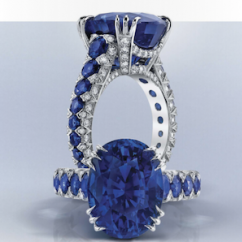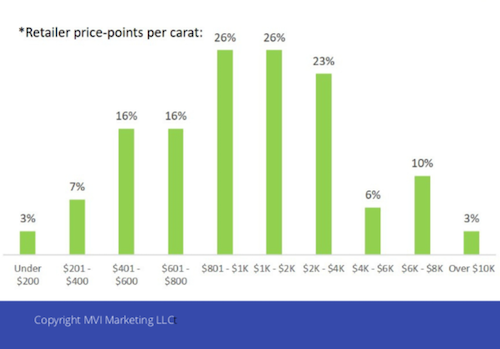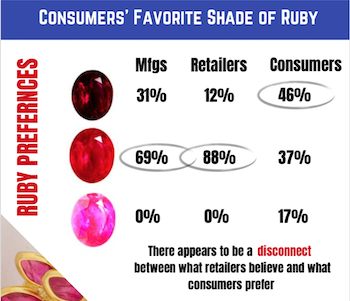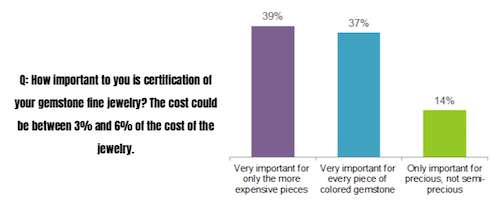Articles and News
Study Finds Good Retailer Margins On Color, But A Disconnect With What Consumers Want | February 09, 2021 (0 comments)

Austin, TX—Diamonds may be both forever and a girl’s best friend, but don’t ignore color. In the latest research from MVI Marketing (The MVEye), a resounding 93% of American jewelry consumers say they either like or love jewelry containing ruby, emerald, or sapphire stones—including engagement rings. Image: A sapphire and diamond ring from Omi Privé.
MVI’s Fall 2020 Comprehensive Consumer and Trade Colored Gemstone Market Research Study surveyed over 1,100 U.S. consumers who had purchased fine jewelry within the past two years. MVI also surveyed more than 100 members of the jewelry trade, including both retailers and manufacturers.
The survey, conducted in Q4 2020, found that despite retail uncertainty due to the pandemic, consumers expressed a greater interest in not just fine jewelry, but precious colored gemstone jewelry with rubies, emeralds, and sapphires. Holiday sales results at better jewelry stores confirmed the pandemic has proven to be a boon to fine jewelry sales.
Related: The Centurion 2020 Holiday Sales Success Index: Season Totals Astound Jewelers
Of the "Big Three" colored gemstones, however, sapphire is by far the top revenue generator for both manufacturers and retailers, with rubies and emeralds next. The MVI study was commissioned by FURA, an international colored gemstone mining company.
“Precious color is once again a clear winner for the consumer seeking fresh looks in fine jewelry styles and for the trade trying to capture the imagination of self-purchasing females and next-gen jewelry buyers,” said Marty Hurwitz, CEO of MVI Marketing. “Bridal jewelry with precious colored gemstones saw the largest category increase from both consumers and jewelry retailers.”
Retailer Carolyn Brigman of McCaskill & Company, Destin, FL, said, “We love the colored stone category and so do our customers. Our clients, once they discover the allure of colored stones’ incredible beauty, come back over and over to expand their color collection. We know once they’ve purchased one, we’ll be seeing them for years to come.”
Retailers and manufacturers, meanwhile, have been observing upticks in colored gem sales. The 100+ who participated in the trade study were asked about their last normal year of sales (2019) and what they are projecting in the future for the category. A large number who carry color said sales already had been trending up between 2018 and 2019. And for 92% of manufacturers and 75% of retailers, the margins on colored gem jewelry are better than diamond jewelry—sometimes significantly so. For retailers especially, margins on color are twice as high: 65%, vs. 33% for diamonds. For manufacturers, it’s less of a differential: 40% for color vs. 30% on diamonds.
Key findings revealed in the U.S. trade and consumer Gemstone Market Research Study report include:
- 40% of younger consumers (23-40) chose sapphire as their favorite [colored] gemstone, closely followed by ruby and emerald, with half of this group already having purchased sapphire jewelry.
- Colored gemstone bridal combinations have grown considerably over the past 10 years in terms of consumer demand and what retailers are offering. Consumer interest in, and acceptance of, colored gemstone engagement rings has risen to over 30%. Current data shows that retailers have increased their colored gemstone wedding jewelry to 15% of their posted website product.
- Consumers showed an extremely high interest in fancy sapphires of all colors including green, yellow, black, and multicolored.
- Natural precious colored gemstone jewelry comprises on average 47% of a jeweler’s total colored gemstone business for the retailers participating in the study, compared to 13% for man-made precious colored gemstone jewelry.
- The retail price sweet spot for more than half (52%) of retailers in the study is $800 to $2,000, while 42% said over $2,000.

MVI's research shows the sweet spot for colored gemstone jewelry pricing (per carat) is between $801 and $2,000, but almost 42% of respondents total indicated they were comfortable with higher price points.
Got the blues! Whether it’s the Kate Middleton Effect or just a desire for something different than the usual diamond engagement ring, wedding combos of diamond and sapphire are gaining steam. 38% of consumers in the study said they would “choose or recommend” an engagement or wedding ring with sapphire. Ruby ranked second at 27%.The study quoted a consumer in Chicago who observed that addition of colored gemstones brought "life" to retailers' engagement ring display cases.
Proving yet again that color is subjective, the survey turned up a notable retailer/consumer disconnect around gemstone color preferences. Consumer respondents were shown color examples for both ruby and blue sapphire, and asked to identify their favorite shade. In both cases, consumers chose the darkest shades. (Emeralds were not surveyed). 46% of consumers chose the darkest blue for their sapphire preference, compared with 40% who chose a medium blue. Only 14% chose a light blue. When shown pictures of non-blue sapphires, consumers overwhelmingly reacted favorably, even if they weren’t aware of their existence prior—but far fewer retailers thought their customers would be interested in those stones.
The most significant disconnect between consumer preferences and retailer assumptions was for rubies. 46% of consumers selected the darkest ruby shown as their preferred color—but only 12% of retailers guessed that shade would be the consumer favorite. By contrast, an overwhelming majority of retailers and manufacturers both assumed consumers would prefer a medium-toned ruby. And both guessed wrong on light pinks: 17% of consumers expressed a liking for them, but retailers and manufacturers alike dismissed them out of hand.

Chart: MVI Marketing
Consumers prefer both rubies and sapphires to be set in white gold, and unlike diamonds where round is the dominant shape, consumers prefer oval for colored gems by an average 2:1 margin.
Another very concerning area of trade/consumer disconnect is around ethics, origin, and sustainability. 42% of consumers surveyed were concerned with origin of the gems in the jewelry they buy, while nearly half were concerned with how workers are treated along the supply chain. But trade respondents don't seem to care as much about the country of origin of the gemstones they buy as consumers do. To the trade; value is what's most important.

A sizable portion of consumers are willing to pay more to have their colored gemstone jewelry accompanied by a third-party certification that indicates gemstone species, treatment, quality of cut and sometimes its origin. Chart: MVI Marketing.
Retailers and manufacturers did agree they don't advertise color enough. Targeted educational and sales training for precious color--something retailers, manufacturers, and wholesalers all said they want--could be the key to growing sales for all colored gemstones.







